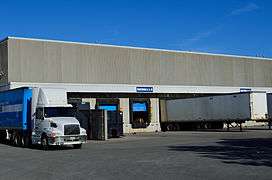Loading dock

A loading dock or loading bay is an area of a building where goods vehicles (usually road or rail) are loaded and unloaded. They are commonly found on commercial and industrial buildings, and warehouses in particular.
Loading docks may be exterior, flush with the building envelope, or fully enclosed. They are part of a facility's service or utility infrastructure, typically providing direct access to staging areas, storage rooms, and freight elevators.[1]
Basics
In order to facilitate material handling, loading docks may be equipped with the following:
- Bumpers – protect the dock from truck damage, may also be used as a guide by the truck driver when backing up.
- Dock leveler – a height-adjustable platform used as a bridge between dock and truck, can be operated via mechanical (spring), hydraulic, or air powered systems.
- Dock lift – serves same function as a leveler but operates similar to a scissor lift to allow for greater height adjustments.
- Dock seals – compressible foam blocks against which the truck presses when parked; seals are used at exterior truck bays in colder climates where this will provide protection from the weather.
- Truck or vehicle restraint system (dock lock) – a strong metal hook mounted to the base of the dock which will hook to the frame or bumper of a trailer and prevents it from rolling away during loading operations, can be operated via manual, hydraulic, or electrical systems; this system can replace or work in conjunction with wheel chocks.
- Dock light – a movable articulating light mounted inside the dock used to provide lighting inside the truck during loading operations.
- Indicator lights that show truck drivers when to back in or pull out.
- Loading dock software – provides a method for tracking and reporting on the loading dock activity.
Warehouses that handle palletized freight use a dock leveler, so items can be easily loaded and unloaded using power moving equipment (e.g. a forklift). When a truck backs into such a loading dock, the bumpers on the loading dock and the bumpers on the trailer come into contact but may leave a gap; also, the warehouse floor and the trailer deck may not be horizontally aligned. In North America, the most common dock height is 48–52 inches (120–130 cm), though heights of up to 55 inches (140 cm) occur as well.[1] A dock leveler bridges the gap between a truck and a warehouse to safely accommodate a forklift.
Where it is not practical to install permanent concrete loading docks, or for temporary situations, then it is common to use a mobile version of the loading dock, often called a yard ramp.
Dangers
There can be very serious accidents on loading bays. One example is trailer creep (also known as trailer walk, or dock walk), which occurs when the lateral and vertical forces exerted each time a forklift truck enters and exits the trailer cause the trailer to slowly move away from the dock, resulting in separation from the dock leveler. Factors that affect trailer creep are the weight and speed of the lift truck and load, the gradient of the ground the trailer is parked on, the condition of the suspension, tire air pressures, the type of transition being used (dock levelers, dock boards), and whether the trailer has been disconnected or if it is still connected to the tractor.
Separation of a vehicle from the loading dock also occurs when a driver prematurely pulls away while the truck is still being loaded/unloaded. This issue is usually caused through a driver not correctly observing traffic lighting signals on a loading bay which prohibit the movement of the trailer. It is also important to ensure that drivers are adequately trained on the safe system of work they are expected to follow.
Loading zone
In different parts of the world, a section of a public or private road may be allocated for loading goods or persons, at specific or at all times. There are parking signs and/or road markings to warn motorists of parking regulations. These areas are known as loading zones or loading bays in many jurisdictions. They are generally monitored by parking inspectors, and vehicles found to be violating the rules can be towed or fined. [2][3]
 Typical warehouse exterior showing loading docks
Typical warehouse exterior showing loading docks An interior loading dock at the New Research Building, Harvard Medical School
An interior loading dock at the New Research Building, Harvard Medical School A reinforced concrete loading dock under construction
A reinforced concrete loading dock under construction
References
- 1 2 Sophia Greenbaum. "Whole Building Design Guide: Loading Dock". National Institute of Building Sciences. Retrieved 2008-02-26.
- ↑ Archived November 11, 2013, at the Wayback Machine.
- ↑ Archived February 28, 2014, at the Wayback Machine.
External links
 Media related to Loading bays at Wikimedia Commons
Media related to Loading bays at Wikimedia Commons